North East Universities Gender Day 2025: Advancing Research on Gender Economics
On April 3, 2025 we launched the first North East Universities Gender and Development (NEUGD) Conference, bringing together early-career and senior scholars from universities in the northeast United States to explore the role of gender in the economy.
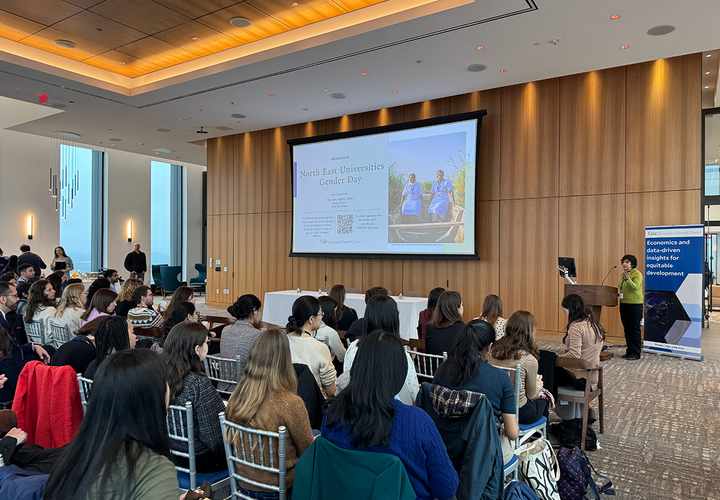
Historically, the economics of gender has not been a subfield on its own, but rather a cross-cutting theme that has gained recognition over recent years. This conference aimed to provide a forum for economists who are interested in topics related to gender to share research across departments and across more traditional subfields of economics.
The day-long conference featured twelve presentations by PhD students, covering topics ranging from gender disparities in the labor market and the home to the impact of abortion bans on maternal and infant health. The program also included a faculty panel Q&A and “pitch coffee rounds”—an opportunity for PhD students to present early-stage research ideas in small groups and receive feedback.
Theme 1. Policies on Reproductive and Infant Health
The first theme investigates how policies shape women's reproductive health and and infants’ health outcomes, with particular attention to structural inequalities and unintended consequences.
Raymond Caraher (University of Massachusetts Amherst) presented on the impact of abortion bans on reproductive and infant health, using Texas's 2021 six-week gestational ban as a case study. Following the ban, infant morbidity and mortality increased by 4-6%, with the most severe effects on black non-hispanic infants. The ban also led to shorter interpregnancy intervals and negative spillover effects on the healthcare system.
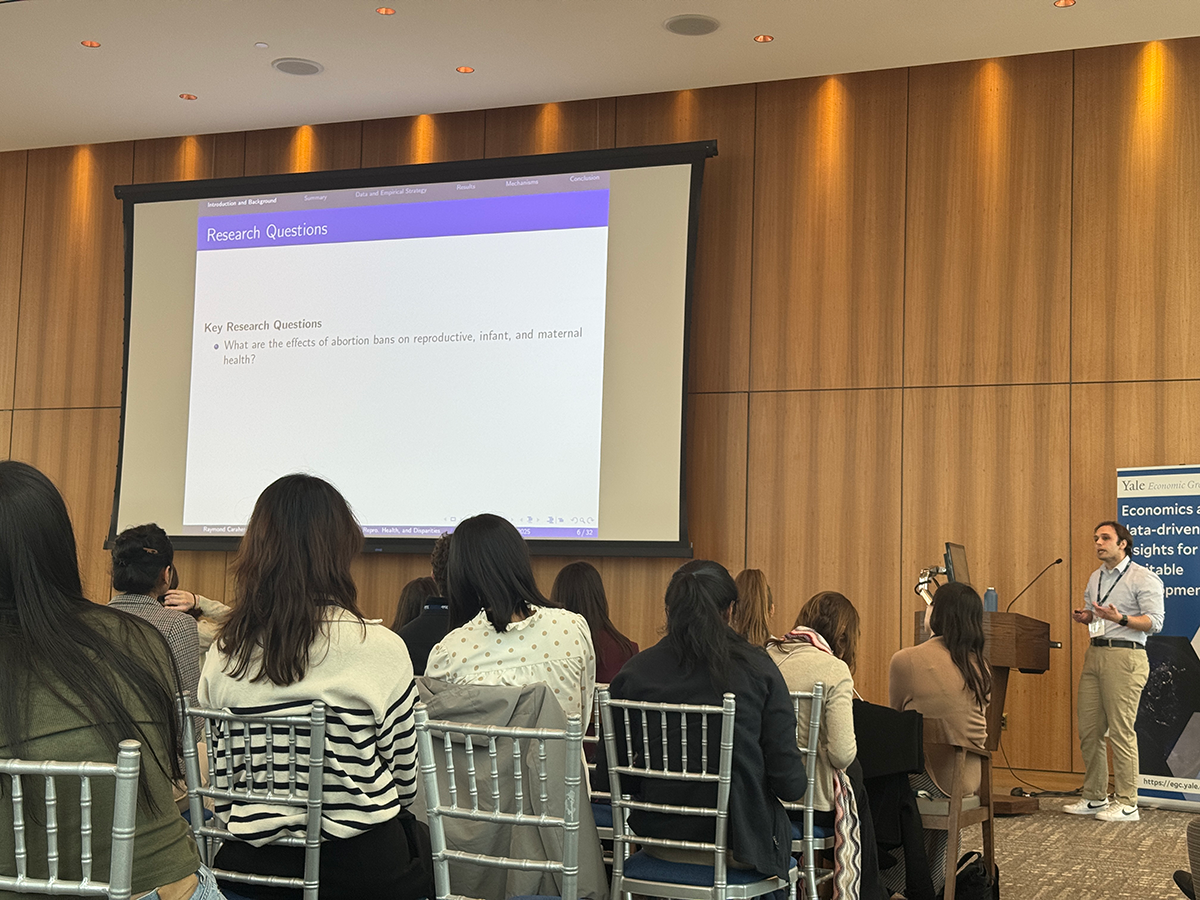 Jackson Martin
Jackson Martin
Raymond Caraher presents at the 2025 North East Universities Gender Day conference.
Theme 2. Gender Differences in Labor Search, Compensation and Evaluation
These papers explore how gender differences in preferences, trade-offs women face, and firm behaviors contribute to persistent wage and opportunity gaps.
Corinne Stephenson (Boston University) explored how gender differences in job search behavior and preferences contribute to the gender wage gap. Using data from the US, she finds that women search more than men but receive fewer offers per search input. Women also value non-wage amenities more highly and are less likely to accept jobs requiring longer commutes or relocation. These differences in amenity valuations account for 19% of the gender wage gap.
Savannah Noray (Harvard) highlighted the tradeoff women face between social tasks (where they have a comparative advantage) and workplace flexibility (which they often value). This creates a difficult choice: women must often forgo flexibility to work in jobs matching their skill sets, or vice versa.
Nancy Wang (MIT) investigated employer beliefs about negotiation in the gender earnings gap. Her research identified a 3-5% gender gap within employer-occupation sets, driven by initial non-salary components. Data showed that women were negotiating at similar rates as men and with similar success rates. The gap appeared to stem from firms making different initial offers to women, particularly in bonus compensation.
Marcela Carvalho (Harvard) examined market reactions to CEO performance by gender. Her research identified an asymmetry: male CEOs receive "the benefit of the doubt" from market participants, particularly male analysts, who under-react to bad news from male-led companies compared to their response to female CEOs presenting similar results.
Theme 3. Care Work and Gender Inequality
This theme highlights how caregiving roles, occupational flexibility, and institutional support shape labor market outcomes for parents and contribute to the child penalty.
Ahmet Gulek (MIT) explored the occupational heterogeneity of child penalties in the United States. His research found that occupational sorting explains one-third of the income penalty for women and almost all of it for men. Flexibility factors, particularly the availability of part-time work, are associated with reduced inequality in employment penalties.
Dana Scott (Yale) examined how remote work affects motherhood penalties in Sweden. Despite the country's reputation for gender equality, motherhood penalties remain substantial. Scott's research found that while remote work has expanded across occupations since the pandemic, those facing the largest child penalties often have the least ability to participate in remote work.
Dyah Pritadrajati (Yale) examined the effects of kindergarten access on labor allocation and household dynamics. Using data from Indonesia, she shows that even when only offering part-time care, kindergarten enrollment was associated with a 13 percentage point increase in mothers' labor force participation. For fathers, enrollment had no effect on labor force participation but was associated with increased wages.
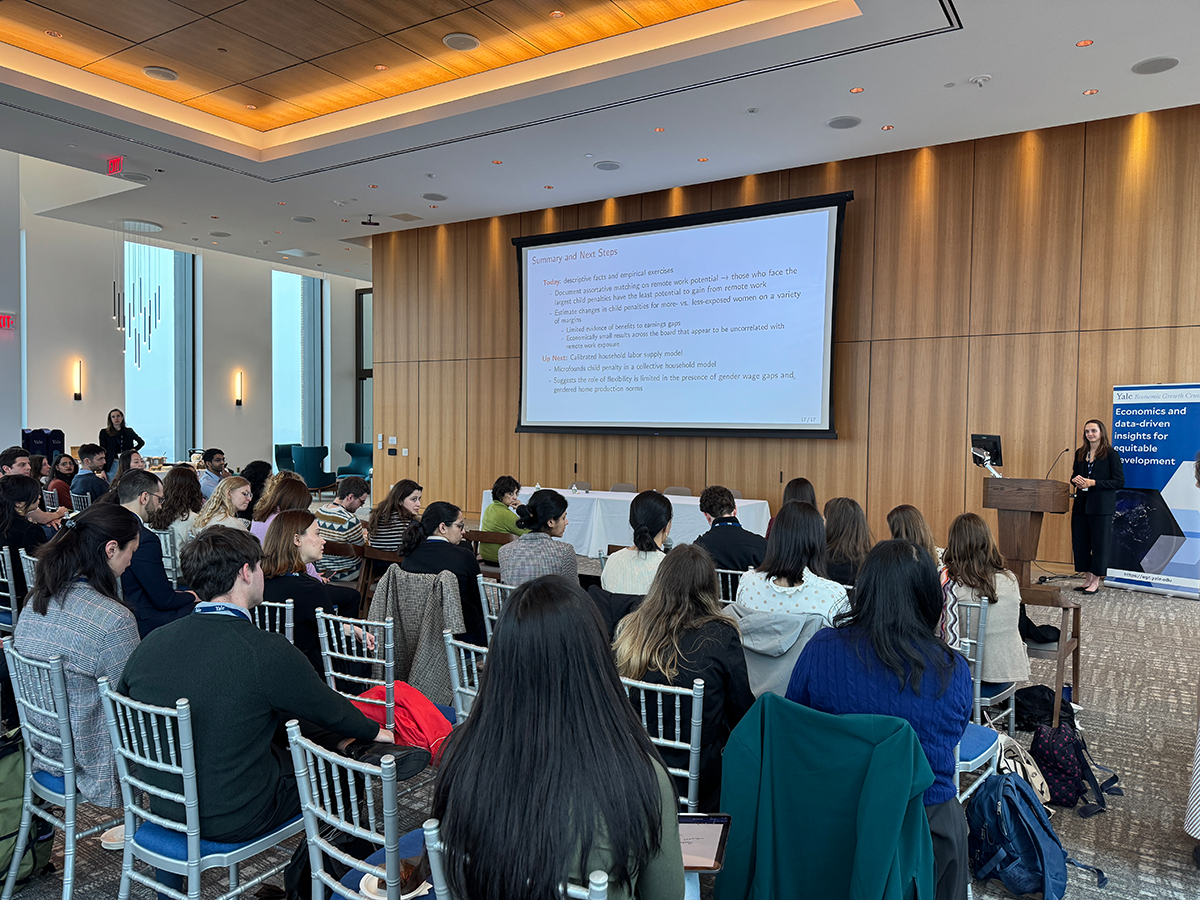 Jackson Martin
Jackson Martin
Dana Scott answers a question from the audience at the 2025 North East Universities Gender Day conference.
Theme 4. Intra-Household Dynamics and Economic Agency
These studies examine how formal rights and the structure of work opportunities can influence labor supply decisions and control over economic resources, especially within the household.
Kailash Rajah (MIT) presented research on how workplace gender composition and spousal jealousy influence women’s labor force participation. In an RCT in Bihar, he found that women are significantly more likely to apply for and accept jobs in women-only workplaces. By including a treatment that directly addressed concerns about women’s safety, Rajah was able to isolate spousal jealousy as a key constraint. His findings highlight how household dynamics and male partner insecurities can play a critical role in shaping women’s labor market decisions.
Akanksha Vardani (Columbia) presented research showing that formal rights—such as property ownership—may have limited impact on women’s empowerment if those rights are not recognized or understood. In an RCT in rural Maharashtra, India, Vardani evaluated an awareness campaign that informed both spouses about women’s legal co-ownership of property and provided households with physical proof of ownership. The intervention led to a 40% increase in women’s private share of household consumption and a 33% reduction in men’s alcohol use. The study indicated that documented ownership differs from effective ownership, highlighting the importance of last-mile efforts to increase awareness of existing policies.
Ruchi Mahadeshwar (Brown University) showed in a field experiment with sex workers in Cambodia that expanding access to better-paying outside job opportunities reduced sex work hours by 13% and increased overall earnings—without the negative consequences associated with criminalization. Her findings show that policies leveraging workers’ responsiveness to prices can decrease the size of the market for sex without compromising worker welfare.
Theme 5. Sexual Identity and Intergenerational Mobility
This research explores how sexual identity shapes economic mobility across generations—a critical but vastly underexplored dimension of inequality.
Cameron Deal (Harvard) presented research on the intergenerational mobility of LGBQ+ individuals, finding that absolute upward mobility is 6-9 income percentiles lower on average for sexual minorities compared to straight populations with similary family backgrounds. LGBQ individuals are 10-15 percentage points less likely to surpass their parents' income rank. This gap is primarily driven by LGBQ men and exceeds the Black-white income rank gap by approximately 50%.
Faculty Q&A: Guidance for Gender Economics Research
The conference included a faculty Q&A session with Joanna Venator, Ursina Schaede, Bilge Erten, and Rohini Pande. Discussion points included:
- The role of gender in the economy concerns everyone, not just women, and it is important to encourage more men to engage in the field
- Suggestions for researchers to continue pursuing gender-focused grants
- Perspectives on finding advisors even when no faculty in the department focus on gender-related topics
- Perspectives on finding coauthors, and whether to pursue collaborations with those who have more complementary or similar skill sets
“Gender economics is really just applying standard methods from other fields to explore how economics outcomes vary by gender. You don’t need a gender-focused advisor — what matters most is finding someone with the methodological skillset to help you implement your idea well.” - Joanna Venator
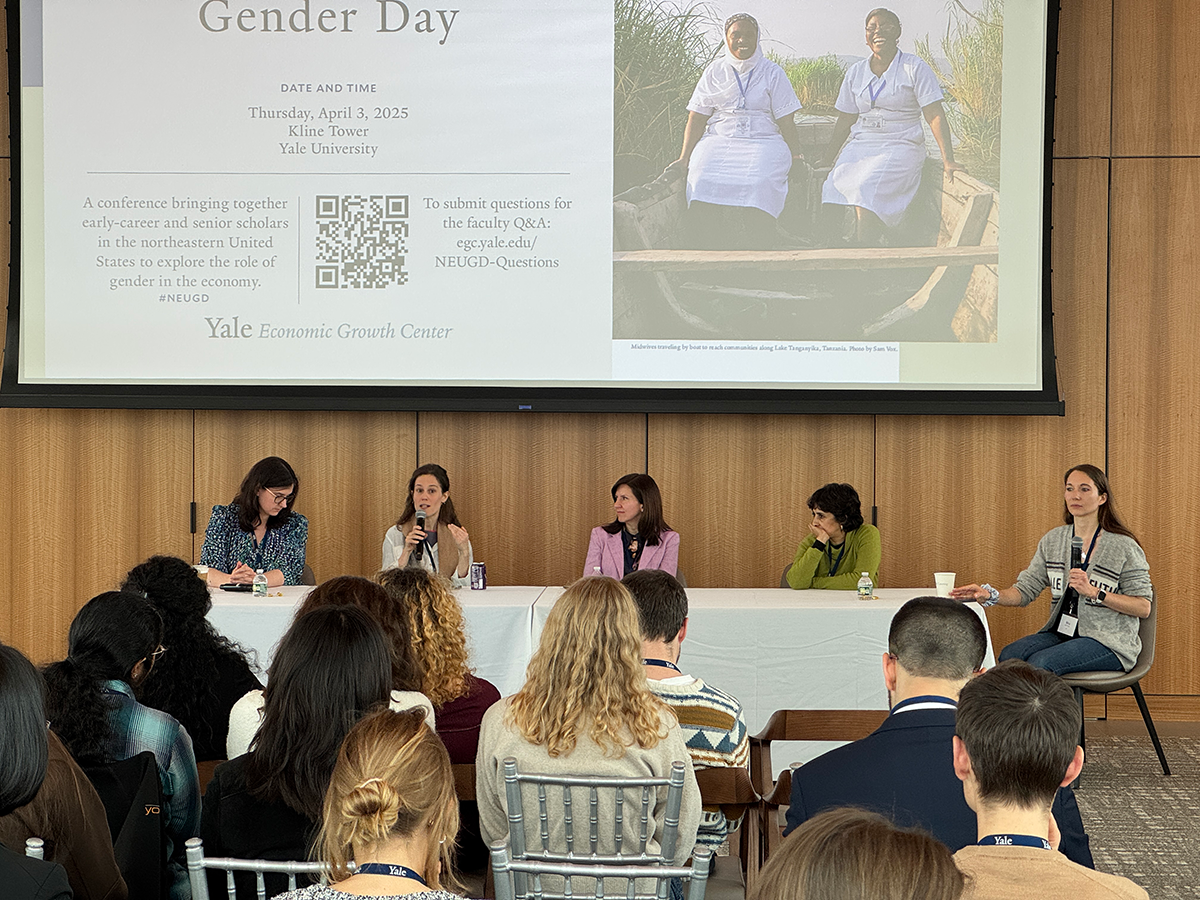 Jackson Martin
Jackson Martin
The faculty Q&A panel answers questions from attendees at the 2025 North East Universities Gender Day conference.
Pitching early stage ideas for PhD students
One of NEUGD’s key goals was to foster connections between early-career researchers and more senior scholars, while providing a space for feedback on emerging research ideas related to gender. The “Pitch Coffee Rounds” were designed with this in mind. Participating PhD students were grouped by research interest with one to two faculty or postdoc. Each student gave a five-minute pitch of their idea, followed by a ten-minute discussion with faculty and other students. These small-group conversations created a supportive environment to exchange feedback, refine ideas, and spark potential collaborations.
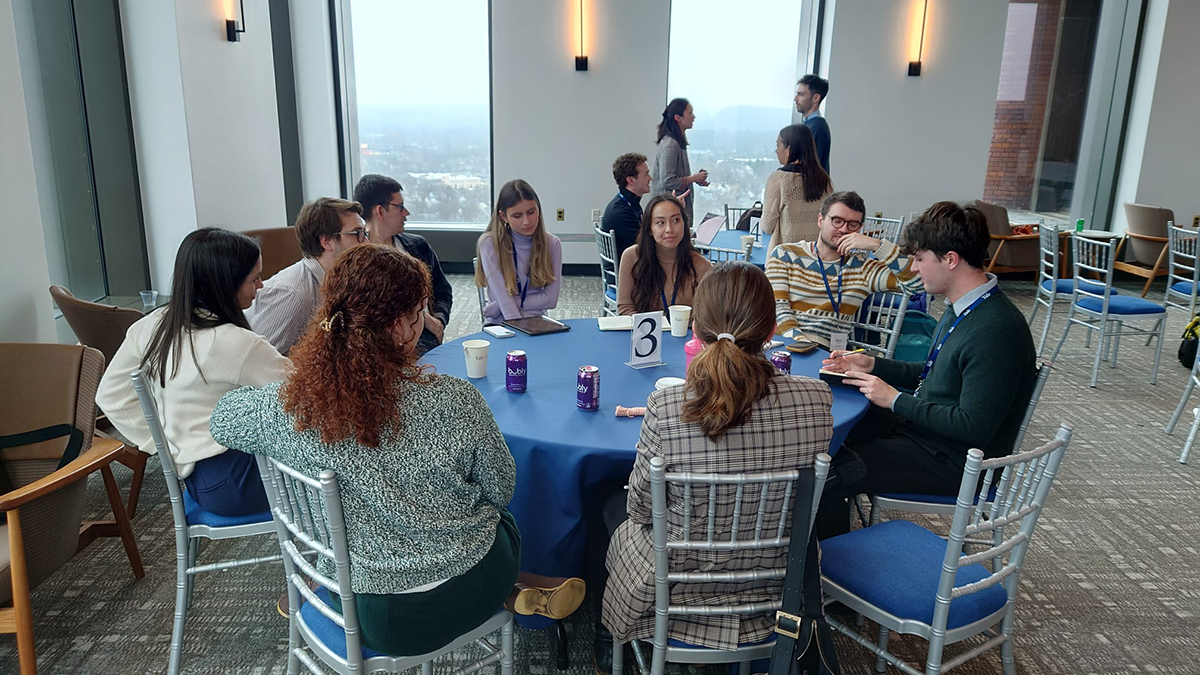
NEUGD attendees discuss research during the conference's pitch coffee rounds.
Toward the Next NEUGD
In her closing remarks, Rohini Pande (Yale University) emphasized the importance of not only documenting gender disparities, but also rigorously investigating their underlying causes—so that meaningful, evidence-based solutions can emerge. She encouraged researchers to ask bold questions that speak to today’s most urgent policy priorities. Her words captured the spirit of NEUGD: a space for early-career scholars to engage deeply with the mechanisms that drive inequality based on gender. We hope that NEUGD will become a rotating event hosted annually by universities across the region, continuing to foster connection, mentorship, and new research.